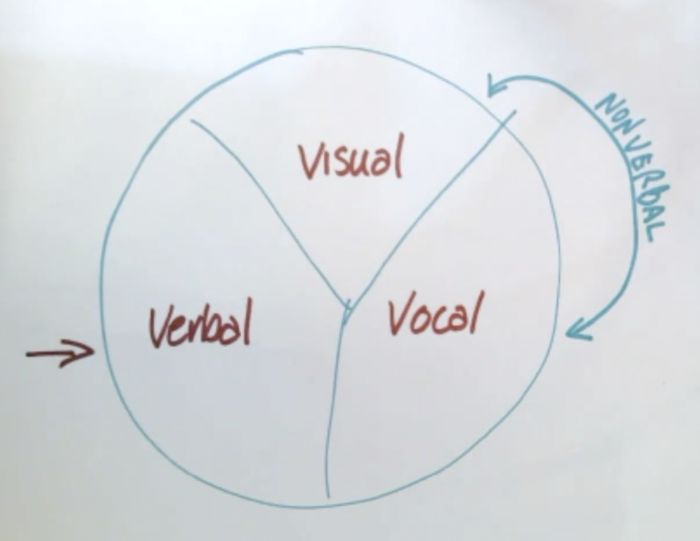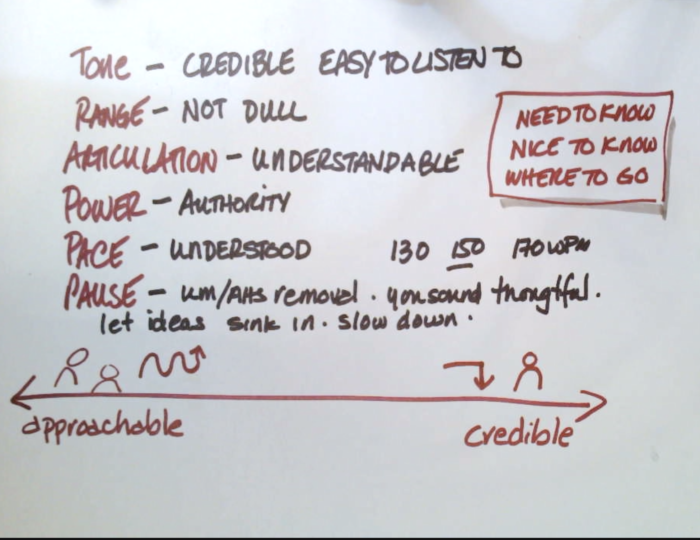Perfecting Your Voice & Body Language
We are always leaving an impression, and we have to make sure that it’s the impression we want to be leaving. That’s our personal brand. Imaging you just had an interview and now they’re talking about you. What 3 words would you like the interview to use to describe you?
Intelligent, Approachable, Authentic, Empathetic, Passionate, Confident, Tolerant, Friendly, ….
Each of these words has a look and a sound.
You can download this workbook as you go through this exercise
How are impressions formed?

What you say, what your body language looks like, and how you sound. What you say is essential. It’s the basis of them making decisions about you. The nonverbal are the lens in which you are viewed through. For example: What does “friendly” look and sound like?
What you say, what your body language looks like, and how you sound. What you say is essential. It’s the basis of them making decisions about you.The nonverbal are the lens in which you are viewed through. For example: What does “friendly” look and sound like?
We are always being judged on a continuum being appearing approachable and being credible. They are based on your body language and your tone of voice.
The Visual
Note: These sections are far more effective watching the video, but the captions are here in any case.
Body language. The straight body language is more credible, though the more approachable’s person head may be more tilted.
Approachable vs Credible. Approachable can be bubbly or sound bubbly. The credible’s voice is a little flatter and goes down in the end bringing a finality to your sound.
On camera vs. live. When on camera you have to be still, you have less space to work with. So fill up as much of the video space as you can.
Seating. Sit in the first 1/3 of your seat to keep your diaphragm open, knees at a 90 degree angle, and feet flat on the floor.
Lighting. If you’re on Zoom, next to the audio icon, there’s a carrot dropdown. Go to video settings, and click on adjust for low light. This will bring more light to your face. Keep the amount of light behind you to a minimum.
Background. Make sure the background you have reflects your brand. Let’s say you want to work at a library, then a background with books may reflect the image you want.
The Vocal

How you sound is very important!
Tone: Exercise on how to increase vibration in your voice. How to speak from your chest to bring thickness in your voice so you have more credibility.
Range: it’s the opposite of monotone, so we don’t appear dull. When I make eye contact, my voice goes up and down. Hand gestures help you get more range.
Articulation: makes you more understandable.
Warm up articulators: These are your lips, teeth, tip of tongue. Before the interview, warm up your articulators. This can’t be explained, but rather heard through the video.
Power: We want power in our voice because power gives us authority. The video also shows how to use your body to use your diaphragm to add authority to your voice.
Pace: makes us well understood. 130-170 wpm. Speed up when you want to show excitement or match the interviewer’s pace. Slow down when you want to enunciate, if your native language isn’t the native language of the person interviewing you, or when you’re presenting complex information.
Don’t rush: If time is an issue, think about what the interview needs to know, what’s nice to know, and where can they go if you run out of time. This way you can include the right information with the time you have, and you never have to rush.
Pause: removes ums and uhs. It makes you look thoughtful. You can let ideas sink in. You can slow down using a pause. You will feel more control over the conversation with pause.
If we take a deeper look at our visual and vocal part, you will leave the impression you want people to describe you.
Next, you always want to prep for the interview. Research the company, the interviewer, what about the job is exciting for you + 20 questions the interview might ask you. Doing that brings confidence.
And last, before you even turn on the camera to start the interview, take 3 deep belly breaths. It will help you start by feeling more confident.
When you do all these things, you’re going to knock your interview out of the park.
Laurie Brown’s Branding Principles to Help You Stand Out

is a global communications expert, who works with professionals who need to use compelling communication to influence and persuade
